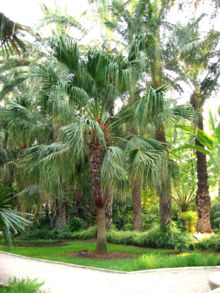Livistona chinensis: Difference between revisions
No edit summary |
Conan Wolff (talk | contribs) making new section Description |
||
| (8 intermediate revisions by 5 users not shown) | |||
| Line 18: | Line 18: | ||
[[File:Livistona chinensis MHNT.BOT.2017.10.17.jpg|thumb|''Livistona chinensis'' - [[MHNT]]]] |
[[File:Livistona chinensis MHNT.BOT.2017.10.17.jpg|thumb|''Livistona chinensis'' - [[MHNT]]]] |
||
'''''Livistona chinensis''''', the '''Chinese fan palm'''<ref name=gopalmtrees/> or ''' fountain palm''',<ref name=NRCS>{{PLANTS | symbol = LICH3 | taxon = Livistona chinensis | accessdate = 6 March 2017}}</ref> is a species of subtropical [[palm tree]] of east Asia. It is native to southern Japan, [[Taiwan]], the [[Ryukyu Islands]], southeastern China and [[Hainan]]. In Japan, two notable populations occupy islands near the coast of Miyazaki Prefecture, [[Aoshima, Miyazaki| |
'''''Livistona chinensis''''', the '''Chinese fan palm'''<ref name=gopalmtrees/> or ''' fountain palm''',<ref name=NRCS>{{PLANTS | symbol = LICH3 | taxon = Livistona chinensis | accessdate = 6 March 2017}}</ref> is a species of subtropical [[palm tree]] of east Asia. It is native to southern Japan, [[Taiwan]], the [[Ryukyu Islands]], southeastern China and [[Hainan]]. In Japan, two notable populations occupy islands near the coast of Miyazaki Prefecture, [[Aoshima, Miyazaki|Aoshima]] and Tsuki Shima.<ref>{{cite web|url=https://ucanr.edu/sites/HodelPalmsTrees/files/256103.pdf |title=Exploring for Palms in Japan}} 14 February 2017. [[University of California Division of Agriculture and Natural Resources]]. Retrieved 24 December 2021</ref> It is also reportedly naturalized in South Africa, [[Mauritius]], [[Réunion]], the [[Andaman Islands]], [[Java]], [[New Caledonia]], [[Micronesia]], [[Hawaii]], [[Florida]], [[Bermuda]], [[Puerto Rico]] and the [[Dominican Republic]].<ref name=WCSP/><ref name=gopalmtrees>{{cite web|title=Chinese Fan Palm |url=http://www.gopalmtrees.com/chinese-fan-palm |website=Palm Trees |accessdate=6 March 2017 |archiveurl=https://web.archive.org/web/20120317121627/http://www.gopalmtrees.com/chinese-fan-palm |archivedate=17 March 2012 |url-status=dead }}</ref> |
||
==Description== |
|||
===Vegetative characteristics=== |
|||
''Livistona chinensis'' can attain heights of about {{cvt|30|to|50|ft|m|0|order=flip}} and a spread of {{cvt|12|ft|m|0|order=flip}}. The leaves are fan shaped.<ref name=gopalmtrees/> |
''Livistona chinensis'' can attain heights of about {{cvt|30|to|50|ft|m|0|order=flip}} and a spread of {{cvt|12|ft|m|0|order=flip}}. The leaves are fan shaped.<ref name=gopalmtrees/> |
||
==Cultivation== |
==Cultivation== |
||
The palm is cultivated as an [[ornamental tree]] in gardens and conservatories.<ref name=Bermuda>{{cite web | title = Chinese Fan Palm | url = http://environment.bm/chinese-fan-palm | publisher = Department of Environment and Natural Resources (Bermuda) | accessdate = 6 March 2017}}</ref> |
The palm is cultivated as an [[ornamental tree]] in gardens and conservatories.<ref name=Bermuda>{{cite web | title = Chinese Fan Palm | url = http://environment.bm/chinese-fan-palm | publisher = Department of Environment and Natural Resources (Bermuda) | accessdate = 6 March 2017}}</ref> It is hardy in [[USDA hardiness zones|USDA zones]] 9-11, tolerating temperatures down to about {{convert|22|F}}.<ref>{{cite book| title=Florida Gardener's Guide| author=Tom MacCubbin, Georgia Tasker| publisher=Cool Springs Press| year=2002| page=113}}</ref><ref>{{cite book| title=Sunset Western Garden Book| year=2007| publisher=Sunset Publishing| page=450}}</ref> |
||
This plant can become a [[weed]], or in some [[ecosystem]]s an [[invasive species]], in places such as Bermuda,<ref name=Bermuda/> Hawaii,<ref name="Hawaii">{{cite web|url=https://www.bea.gov/newsreleases/regional/gdp_state/gsp_newsrelease.htm|title=GDP by State |publisher=BEA, U.S. Department of Commerce|accessdate=2013-08-01}}</ref> Florida [[wetland]]s and on some [[Caribbean Islands]]. |
This plant can become a [[weed]], or in some [[ecosystem]]s an [[invasive species]], in places such as Bermuda,<ref name=Bermuda/> Hawaii,<ref name="Hawaii">{{cite web|url=https://www.bea.gov/newsreleases/regional/gdp_state/gsp_newsrelease.htm|title=GDP by State |publisher=BEA, U.S. Department of Commerce|accessdate=2013-08-01}}</ref> Florida [[wetland]]s and on some [[Caribbean Islands]]. |
||
==References== |
==References== |
||
| ⚫ | |||
{{Reflist}} |
{{Reflist}} |
||
| ⚫ | |||
{{Taxonbar|from=Q709649}} |
{{Taxonbar|from=Q709649}} |
||
Latest revision as of 19:42, 20 January 2024
| Livistona chinensis | |
|---|---|

| |
| Scientific classification | |
| Kingdom: | Plantae |
| Clade: | Tracheophytes |
| Clade: | Angiosperms |
| Clade: | Monocots |
| Clade: | Commelinids |
| Order: | Arecales |
| Family: | Arecaceae |
| Tribe: | Trachycarpeae |
| Genus: | Livistona |
| Species: | L. chinensis
|
| Binomial name | |
| Livistona chinensis | |
| Synonyms[1] | |
| |

Livistona chinensis, the Chinese fan palm[2] or fountain palm,[3] is a species of subtropical palm tree of east Asia. It is native to southern Japan, Taiwan, the Ryukyu Islands, southeastern China and Hainan. In Japan, two notable populations occupy islands near the coast of Miyazaki Prefecture, Aoshima and Tsuki Shima.[4] It is also reportedly naturalized in South Africa, Mauritius, Réunion, the Andaman Islands, Java, New Caledonia, Micronesia, Hawaii, Florida, Bermuda, Puerto Rico and the Dominican Republic.[1][2]
Description[edit]
Vegetative characteristics[edit]
Livistona chinensis can attain heights of about 9 to 15 m (30 to 50 ft) and a spread of 4 m (12 ft). The leaves are fan shaped.[2]
Cultivation[edit]
The palm is cultivated as an ornamental tree in gardens and conservatories.[5] It is hardy in USDA zones 9-11, tolerating temperatures down to about 22 °F (−6 °C).[6][7]
This plant can become a weed, or in some ecosystems an invasive species, in places such as Bermuda,[5] Hawaii,[8] Florida wetlands and on some Caribbean Islands.
References[edit]
- ^ a b c "Livistona chinensis". World Checklist of Selected Plant Families (WCSP). Royal Botanic Gardens, Kew. Retrieved 6 March 2017.
- ^ a b c "Chinese Fan Palm". Palm Trees. Archived from the original on 17 March 2012. Retrieved 6 March 2017.
- ^ USDA, NRCS (n.d.). "Livistona chinensis". The PLANTS Database (plants.usda.gov). Greensboro, North Carolina: National Plant Data Team. Retrieved 6 March 2017.
- ^ "Exploring for Palms in Japan" (PDF). 14 February 2017. University of California Division of Agriculture and Natural Resources. Retrieved 24 December 2021
- ^ a b "Chinese Fan Palm". Department of Environment and Natural Resources (Bermuda). Retrieved 6 March 2017.
- ^ Tom MacCubbin, Georgia Tasker (2002). Florida Gardener's Guide. Cool Springs Press. p. 113.
- ^ Sunset Western Garden Book. Sunset Publishing. 2007. p. 450.
- ^ "GDP by State". BEA, U.S. Department of Commerce. Retrieved 2013-08-01.
